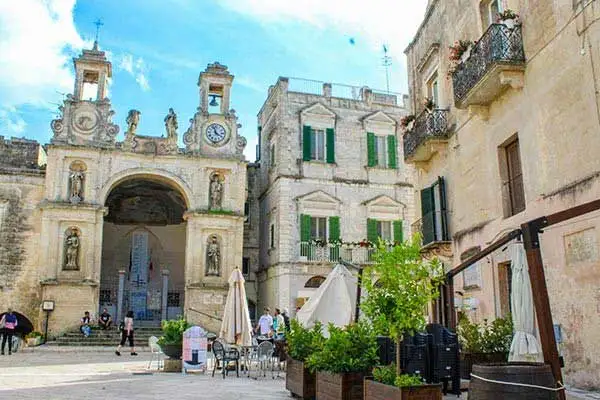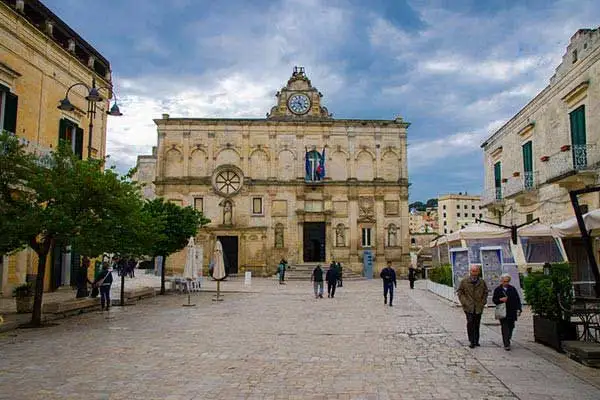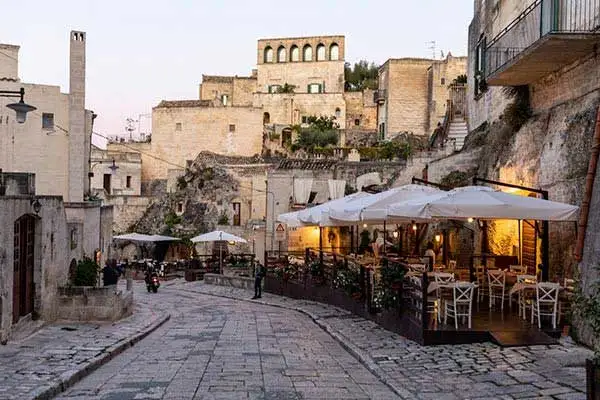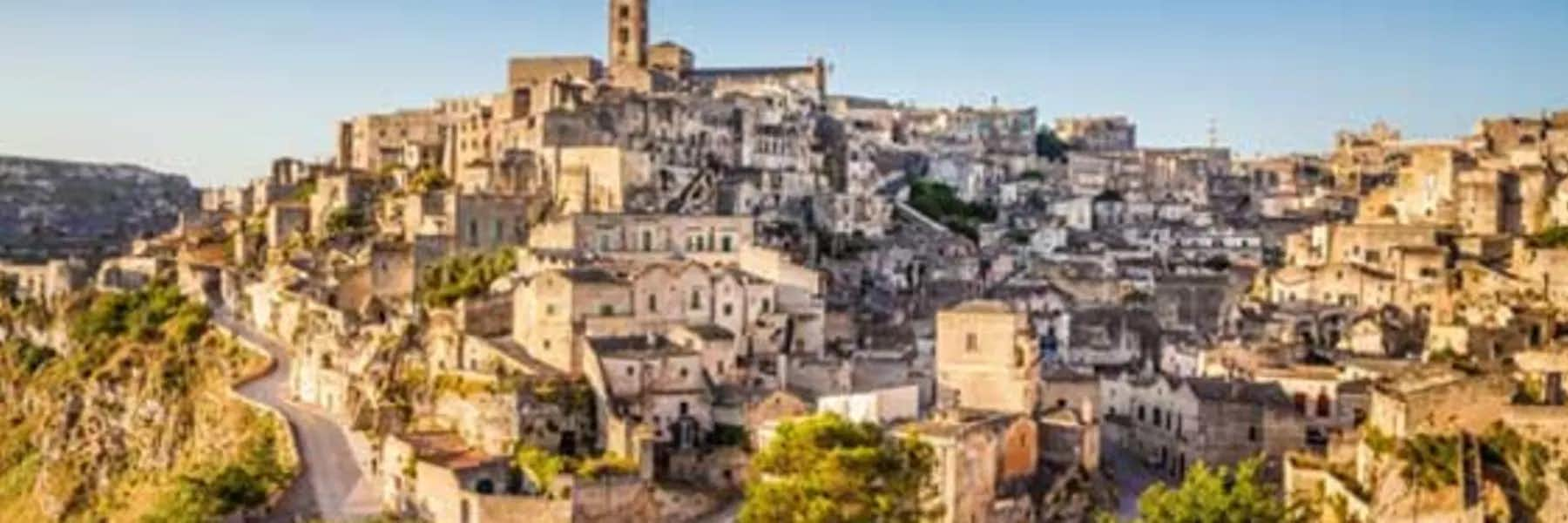By Valerie Fortney Schneider
Matera isn’t your typical Italian city, if there is such a thing. There are no cypress-studded roads, no perfectly symmetrical Renaissance palazzi, and no top-name designer stores crowding the shopping district. No, Matera is anything but typical, and the residents are very proud of that.
The oldest city in Italy—and the oldest in Europe, too—Matera is a UNESCO World Heritage city that was also the European Capital of Culture in 2019. It doesn’t ascend a hill; instead, it scrambles down a ravine, tucked into the folds of the landscape in an architecturally astounding feat of cityscape that is Matera’s attraction, called the Sassi (meaning “rocks”). Its rocky aspect is almost a physical metaphor for Matera’s hardscrabble past. It had periods of splendor, then wars and disease brought widespread poverty and the city’s beautiful and historic Sassi were emptied, deemed unsanitary and left to languish for years before their historical and cultural value was recognized. Today, Matera is flourishing and is one of southern Italy’s most interesting cities.
Retire in Matera

Set in Basilicata near the border with Puglia, Matera is set amidst billowing fields of wheat, olive groves, and grape vines, along the ancient Roman road, the Appian Way. With about 60,000 residents, it is an active city with many long-standing traditions and festivals, and a lot happening throughout the year. It draws visitors from around the world, but doesn’t get that over-run feeling, and the residents still love their evening stroll (the passeggiata) among the piazzas and streets on the level plain above the Sassi, the area of town known as the centro.
Getting around the Sassi takes some effort to climb the ups-and-downs of the pedestrian lanes that make up the bulk of the district. Most Materani now live in the level, more easily accessed centro and pop down to the Sassi for a dinner or a walk. (There is only one vehicular street that traverses the Sassi.) In the city’s centro are the stores, cafes, churches, and many museums—the heart of Matera.
Basilicata prides itself on being hospitable, and you’ll find it in action in Matera where folks are friendly and personable. From here, it’s an easy hop to Puglia, the heel of the boot, with its intriguing sights and towns, and to the southern part of Campania, as well. Matera is just 40 minutes from the beaches on the Ionian Sea.
The climate is considered Mediterranean, with fiercely hot summers (especially July) and fairly mild winters. Expect it to be in the 90s F in July and August, though arid. Winter months see daytime temperatures in the upper 40s F and low 50s F, though it gets colder at night, even close to freezing. There is a dusting of snow once or twice a year, which lends a magical appeal to the city.
Get Your Free Italy Report Today!
Get Your Free Italy Report Today!
Learn more about Italy and other countries in our daily postcard e-letter. Simply enter your email address below and we’ll send you a FREE report – Italy: Europe’s Most Seductive Country.

By submitting your email address, you will receive a free subscription to IL Postcards and special offers from International Living and our affiliates. You can unsubscribe at any time, and we encourage you to read more about our Privacy Policy.
Lifestyle in Matera

With art events, concerts, and festivals, Matera is an active city year-round. They especially love jazz music here, so there is a regular line-up of jams and concerts. One musical venue is set in an old stone quarry, the Cava del Sole, where the tufa rock was mined to build parts of the city. This is an evocative spot with excellent acoustics.
There are several art museums, both traditional and contemporary, and permanent Dali’ sculptures installed around the town in honor of Matera’s Capital of Culture status in 2019. Cocktails on a terrace or piazza, a great meal at a low price, and artisanal gelato—what could be better? The city prides itself on its bread, some of the best in all of Italy, baked in a wood-fired oven, and on the hand-formed pastas (cavatelli and orecchiette), served with simple but tasty sauces. Vegetarians will rejoice at the offerings here, but meat-eaters will love the lamb, steaks, and succulent sausages, too.
Matera is less than an hour from Bari (in Puglia) for city services, attractions, and the airport. The beaches of the Ionian Sea and Adriatic Sea can both be reached in an hour or less.
There are walking paths through the gorges and ravines, national parks in the nearby mountains, and outdoor adventures in the region that include a high-flying zooming zip line and the longest Tibetan bridge in the world, along with waterfalls, ancient traditions, and food festivals around Basilicata.
Many movies have been filmed here—most recently the newest James Bond—and more are slated, so your daily stroll may bring you in contact with some Hollywood stars.
Cost of Living in Matera

Matera has an overall cost of living in line with most of southern Italy, though housing costs have risen in the past few years as more media attention has increased its desirability.
A cappuccino costs $1.50 and you can add in a cornetto (croissant) for $1.20. A glass of wine on the piazza with nibbles will run to $4.50, but go to a neighborhood bar and it will cost even less. A plate of pasta with the region’s heralded crispy fried sweet peppers, called peperoni cruschi, topped with shards of hard ricotta cheese (delicious!) is about $7, and a pizza and beer will set you back about $12. At the upper end, the Michelin-starred restaurant Vitantonio Lombardo is the place for a special celebratory meal, with prices that start at $106 for the five-course tasting menu. A haircut will run from $25 to $50, depending on the cut and stylist. Expect to pay at least $200,000 for a two-bedroom apartment in a central location, but if you want to be in the coveted Sassi, an entry price is around $295,592. Rentals go from around $600 to $1,200 a month in the centro of Matera. A couple can expect to pay $300 a month on groceries and $250 on utilities.
Featured Image Copyright: ©iStock.com














